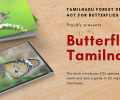Butterfly of the month – February 2019
Common Banded Peacock
Common Banded Peacock (Papilio crino) butterflies are a species of swallowtail butterfly endemic to the Indian subcontinent particularly India, Nepal, Bhutan and Sri Lanka. It was first described by Fabricius in 1793.
Size: 80-100 mm.
Male: Upper forewing with wooly streaks along veins 1.2, and 3. Upperside is black. Green tipped tail hindwing and extensive metallic green dusting of wings and body. Upper forewing bluish green discal band clearly defined and narrowing towards costa. The band does not enter cell Upper forewing and has clearly defined inner edge.
Upper forewing is a broad green discal band from dorsum to vein 7 where it ends abruptly. Underside black with fine white dusting. Under hindwing with a row of sub-marginal pale crescents and a tornal orange ringed black spot. Under forewing pale sub-marginal streaks.
Habits: Fast swift flight. Mostly they are active in high tree canopy but often fly low near the forest streams. Males visit damp patches in good numbers. Both sexes come to flowers. It roosts with open wings.
Habitats: Restricted to lowland mixed deciduous forest. Prefer hot drier habitat.
Distribution: Tamil Nadu, South India, Bengal and Sri Lanka
Egg: The female lays eggs on leaves of the Satinwood tree – Chloroxylon swietenia
Pupa: Curved backward anteriorly; head broad in the front; green.
Adult: The butterfly is solitary and a fast flyer. It flies high above and forages on the trees. However, occasionally it is attracted to bright flowers of plants on the ground as well. It flutters in a hurry while sipping nectar. It is distinguished due to its colour which is a shiny fluorescent blue or green depending on the angle of observation. The magnificent colours are due to scales in the interior of its wings. Also there are spots in the bottom of its hindwings similar to eyespots. The exterior of the wings is brownish black with patterns similar to eyespots. Perhaps the only protection for this species is self-mimicry through the eyespots as regards to its morphology, considering its bright peacock colours and its fast flight.
Life Cycle:

Images credits : P. Mohanprasath, Kalyan Mukherjee
Further readings:




